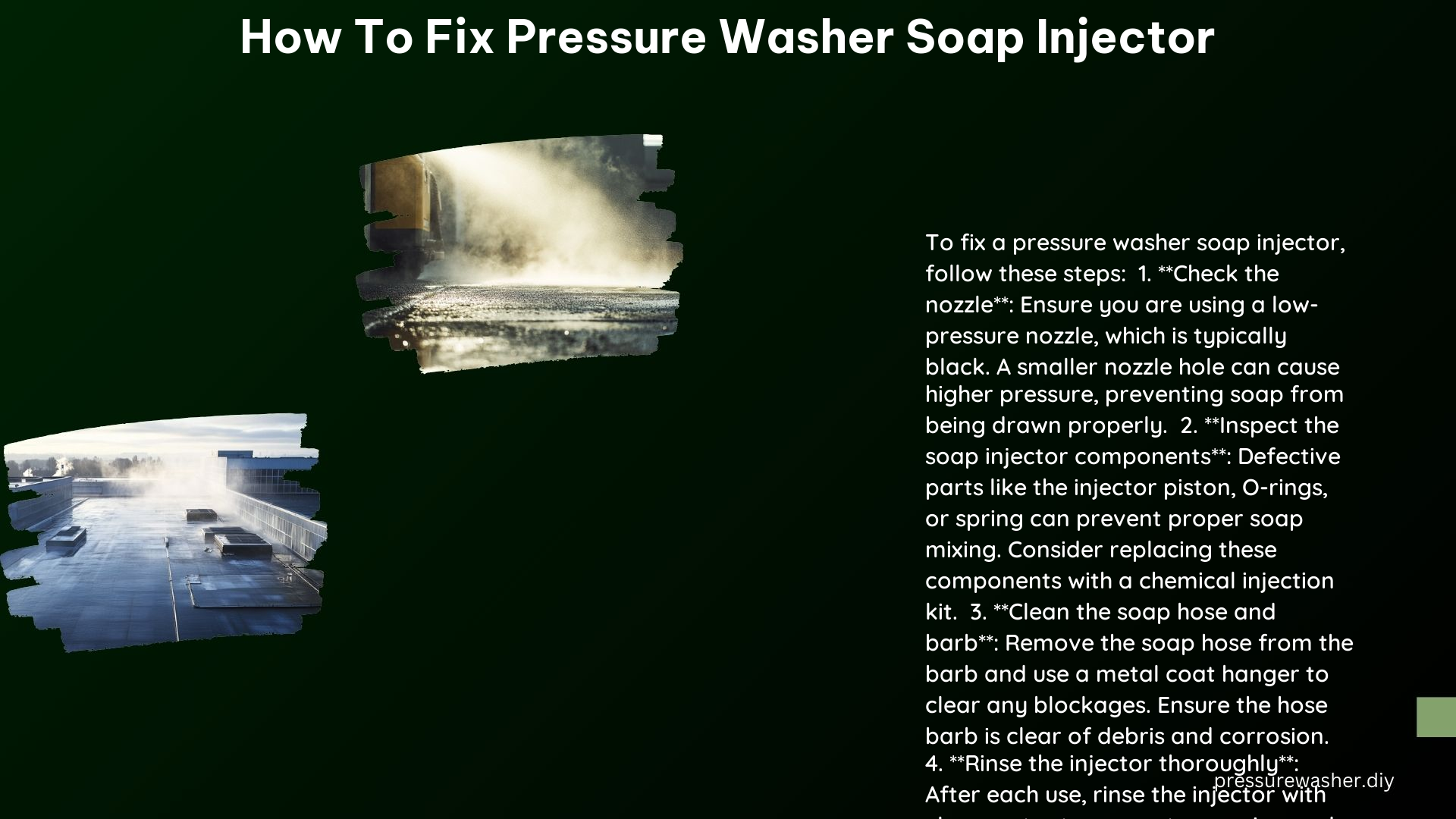If your pressure washer’s soap injector is not functioning correctly, it can be a frustrating experience. However, with the right troubleshooting steps and a bit of DIY know-how, you can often fix the issue and get your pressure washer back in working order. In this comprehensive guide, we’ll walk you through the step-by-step process to diagnose and repair a malfunctioning pressure washer soap injector.
Checking the Nozzle
The first step in troubleshooting a pressure washer soap injector is to ensure you are using the correct nozzle. A low-pressure nozzle is required to draw the detergent solution properly. Refer to your pressure washer’s owner’s manual to identify the recommended nozzle size for your specific model.
It’s important to note that a nozzle with a smaller hole size can provide higher pressure, which can prevent the soap from being drawn into the water stream. Ensure you are using the appropriate low-pressure nozzle, typically marked with a black or white color, to allow the soap to be effectively drawn into the water flow.
Inspecting and Cleaning the Soap Injector

Next, you’ll need to inspect and clean the soap injector. Check for any blockages or corrosion that may be preventing the proper flow of the detergent solution. Use a needle or a metal coat hanger to carefully remove any debris or mineral buildup that may have accumulated in the injector.
If your soap injector has a spring and metal ball, ensure that they are not stuck or jammed. Use a metal coat hanger to gently dislodge the ball if necessary, taking care not to damage the internal components.
Addressing Defective Soap Injector Components
In some cases, the issue may be caused by defective soap injector components, such as the piston, O-rings, or spring. If these parts are worn or damaged, you’ll need to replace them. Consider purchasing a chemical injection kit that contains all the necessary replacement components to ensure a proper fit and function.
Rinsing and Maintaining the Injector
Regular maintenance is crucial for the longevity and proper operation of your pressure washer’s soap injector. After each use, thoroughly rinse the injector to prevent corrosion and clogging. You can also submerge the injector in clean water for a few hours or overnight to ensure it is fully cleaned and ready for the next use.
Troubleshooting and Repair
If the injector is still not drawing soap, try tapping it gently to dislodge any stuck parts. Ensure that all connections, including the hose and soap tank, are secure and not leaking, as this can prevent the injector from functioning correctly.
Replacing Parts if Necessary
If the above steps do not resolve the issue, you may need to replace the soap injector or other related parts, such as the pump, hose, or soap tank. Consult your pressure washer’s owner’s manual or contact the manufacturer for guidance on the appropriate replacement parts and procedures.
Remember, safety should always be your top priority when working on any pressure washer components. Wear protective gear, such as gloves and safety glasses, and follow all manufacturer’s instructions to ensure a successful repair.
Technical Specifications
Pressure Washer Brands
The troubleshooting and repair methods outlined in this guide are applicable to a wide range of pressure washer brands, including Ariens, Bolens, Craftsman, Cub Cadet, Dixon, Echo, Exmark, Green Machine, Homelite, Honda, Huskee, Husqvarna, John Deere, Lawn Boy, MasterCut, Montgomery Wards, MTD, Murray, Poulan, Poulan Pro, Ryobi, Simplicity, Toro, Snapper, Troy-Bilt, Turf King, Weed Eater, Wheel Horse, Worx, Yard Machines, and Yard-Man.
Pressure and Flow Rates
Ensure that your pressure washer is set to the correct pressure and flow rate for the specific nozzle and soap injector being used. Refer to your owner’s manual or the manufacturer’s recommendations to ensure optimal performance and prevent any damage to the equipment.
By following the steps outlined in this comprehensive guide, you’ll be well on your way to diagnosing and repairing a malfunctioning pressure washer soap injector. Remember to take your time, follow safety precautions, and don’t hesitate to seek professional assistance if you’re unsure about any part of the repair process.
